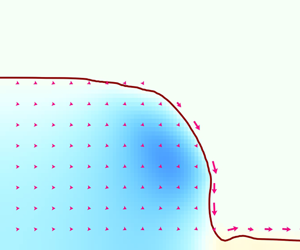Crossref Citations
This article has been cited by the following publications. This list is generated based on data provided by
Crossref.
Lee, Cheng-Hsien
and
Kuan, Yi-Hsuan
2021.
Onset of submerged granular collapse in densely packed condition.
Physics of Fluids,
Vol. 33,
Issue. 12,
Montellà, E.P.
Chauchat, J.
Chareyre, B.
Bonamy, C.
and
Hsu, T.J.
2021.
A two-fluid model for immersed granular avalanches with dilatancy effects.
Journal of Fluid Mechanics,
Vol. 925,
Issue. ,
Meng, Wenkang
Liao, Lei
Yu, Ching-Hao
Li, Jia
and
An, Ruidong
2021.
Eulerian–Eulerian multiphase models for simulating collapse of submarine sediment column with rheological characteristics in air–water flow.
Physics of Fluids,
Vol. 33,
Issue. 11,
Phan, Quoc T.
Bui, Ha H.
and
Nguyen, Giang D.
2022.
Modeling submerged granular flow across multiple regimes using the Eulerian–Eulerian approach with shear-induced volumetric behavior.
Physics of Fluids,
Vol. 34,
Issue. 6,
Zhao, Kai-Li
Qiu, Liu-Chao
and
Liu, Yi
2022.
Two-layer two-phase material point method simulation of granular landslides and generated tsunami waves.
Physics of Fluids,
Vol. 34,
Issue. 12,
Lee, Cheng-Hsien
Lo, Peter H.-Y.
Shi, Huabin
and
Huang, Zhenhua
2022.
Numerical Modeling of Generation of Landslide Tsunamis: A Review.
Journal of Earthquake and Tsunami,
Vol. 16,
Issue. 06,
Lee, Cheng-Hsien
and
Chen, Jia-You
2022.
Multiphase simulations and experiments of subaqueous granular collapse on an inclined plane in densely packed conditions: Effects of particle size and initial concentration.
Physical Review Fluids,
Vol. 7,
Issue. 4,
Rettinger, Christoph
Eibl, Sebastian
Rüde, Ulrich
and
Vowinckel, Bernhard
2022.
Rheology of mobile sediment beds in laminar shear flow: effects of creep and polydispersity.
Journal of Fluid Mechanics,
Vol. 932,
Issue. ,
Athani, S.
Metzger, B.
Forterre, Y.
and
Mari, R.
2022.
Transient flows and migration in granular suspensions: key role of Reynolds-like dilatancy.
Journal of Fluid Mechanics,
Vol. 949,
Issue. ,
Lin, Huan-Cheng
Chen, Kuo-Ching
and
Chen, Chih-Hung
2022.
Electrochemical Change Induced by Spherical Indentation in Lithium-Ion Batteries.
Batteries,
Vol. 8,
Issue. 12,
p.
268.
Gu, Zhenghua
Wang, Tinghui
Meng, Wenkang
Yu, Ching-hao
and
An, Ruidong
2023.
Numerical investigation of silted-up dam-break flow with different silted-up sediment heights.
Water Supply,
Vol. 23,
Issue. 2,
p.
599.
Montellà, E.P.
Chauchat, J.
Bonamy, C.
Weij, D.
Keetels, G.H.
and
Hsu, T.J.
2023.
Numerical investigation of mode failures in submerged granular columns.
Flow,
Vol. 3,
Issue. ,
Guo, Xingsen
Liu, Xiaolei
Zhang, Cheng
Jing, Shaodong
and
Hou, Fang
2023.
Impact of high-speed turbidity currents on offshore spanning pipelines.
Ocean Engineering,
Vol. 287,
Issue. ,
p.
115797.
Xu, Tibing
Sun, Shuangke
and
Wu, Peng
2023.
Simulation of submerged granular flows by development of a two-phase incompressible explicit mesh-free method.
International Journal of Sediment Research,
Vol. 38,
Issue. 4,
p.
530.
Chen, Jun
and
Zhang, Jingxin
2023.
Semi-resolved CFD-DEM coupling model for submerged granular collapse.
Powder Technology,
Vol. 425,
Issue. ,
p.
118624.
Martínez-Aranda, S.
Fernández-Pato, J.
and
García-Navarro, P.
2024.
Mixing-phase model for shear-induced contractive/dilative effects in unsteady water-sediment mixture flows.
Advances in Water Resources,
Vol. 188,
Issue. ,
p.
104710.
Chen, Yu
Suo, Si
Dong, Mingrui
Zhong, Haiyi
Wei, Deheng
and
Gan, Yixiang
2024.
Effects of particle density and fluid properties on mono-dispersed granular flows in a rotating drum.
Physics of Fluids,
Vol. 36,
Issue. 10,
Alhaddad, Said
Keetels, Geert
Mastbergen, Dick
van Rhee, Cees
Lee, Cheng-Hsien
Puig Montellà, Eduard
and
Chauchat, Julien
2024.
Subaqueous dilative slope failure (breaching): Current understanding and future prospects.
Advances in Water Resources,
Vol. 188,
Issue. ,
p.
104708.
Polanía, Oscar
Estrada, Nicolas
Azéma, Emilien
Renouf, Mathieu
and
Cabrera, Miguel
2024.
Polydispersity effect on dry and immersed granular collapses: an experimental study.
Journal of Fluid Mechanics,
Vol. 983,
Issue. ,
Lee, Cheng-Hsien
and
Cheng, Hao-Yu
2024.
Multi-phase simulation for understanding morphodynamics of gravel beaches.
Coastal Engineering,
Vol. 187,
Issue. ,
p.
104422.



